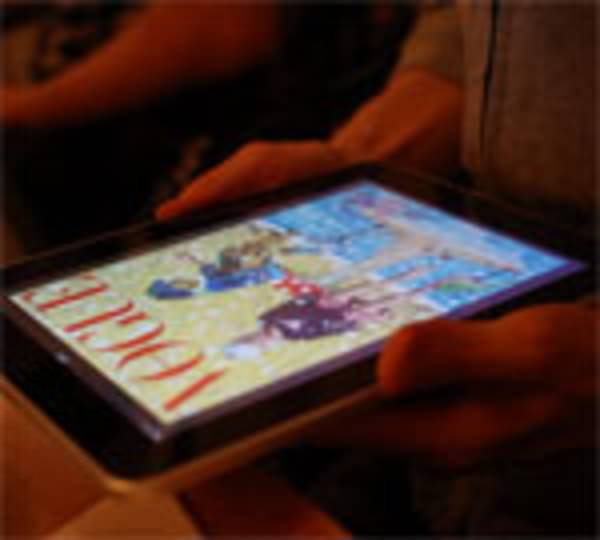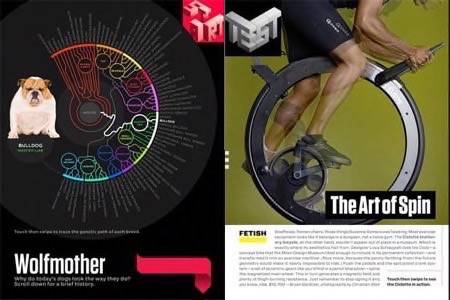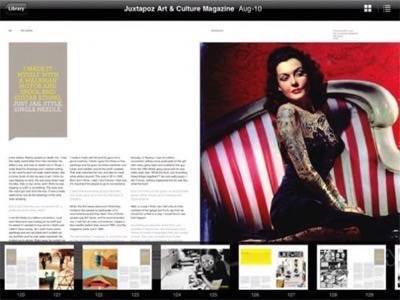When the iPad was launched earlier this year, one of the big talking points was that the iPad might be the savior of magazines. By now many magazines are available on the iPad, either in their own standalone app or in a virtual magazine store. In this post we look at how magazines are using the iPad, what the user experience is like, and what iPad magazines still need to do to improve.

We’ll analyze a standalone iPad magazine app (Wired) and a service that offers access to many different magazines (Zinio).
Note that we’re focusing purely on the user experience of iPad magazines, rather than business matters like profitability or number of downloads.
Wired
Wired magazine has been the most high profile magazine to utilize the iPad’s interactivity. Each new edition costs US$4.99 and is a fairly bulky download – the most recent ‘Web is dead’ edition was 482MB. But it is packed with interactive goodies.
The iPad version of Wired features videos, touchscreen infographics, slideshows, music and more. For example, a story about a small American town called Picher that has been “devastated” by lead and zinc mining, is accompanied by a video featuring Picher locals talking about the impact of mining on their town. It augments the story nicely and brings the reader closer to the issue.

There are some oddities to the Wired app, however. For example, you can’t do the usual pinching motion to enlarge text that is present in most other iPad apps. So if the font type is too small for you to read, you’re out of luck. The blog iA has a thorough critique of this and other issues. Also see our own Sarah Perez’s thoughts on the sometimes confusing features of various iPad magazines.
But overall, Wired’s app is the best example currently of a mainstream magazine utilizing the iPad’s touchscreen and interactive capabilities. Below are two examples of the touchscreen functionality: on the left, the user scrolls with their finger to see a history of dogs; on the right, the user swipes their finger to see a graphical illustration of ‘spin.’

Zinio: Multiple Magazines
Online magazine shops like Zinio offer up multiple magazines for purchase. Zinio aims to duplicate the print magazine reading experience in digital format. This description of itself on Google sums up what Zinio aims to deliver: “Same content. Same design. Delivered over the Internet.”

Reading many of Zinio magazines on iPad is pretty similar to reading PDF files on iPad – there is little in the way of interactivity other than clicking the odd hyperlink and zooming in and out of articles. Some of Zinio’s offerings have interactive features, but not the ones I’ve subscribed to.

So far I’ve purchased subscriptions to an art magazine called Juxtapoz, popular music magazine Rolling Stone, and a lifestyle magazine called The FADER. The main benefits to me are speed of delivery and lower cost. I’ve appreciated getting the latest editions as soon as they come out and not having to pay the premium that international magazine readers pay for print versions.
The reading experience leaves something to be desired, mostly because the text is generally too small to be read on an iPad without zooming in and out constantly. One zooms in to read an article, then zooms back out again to flip to the next page or navigate to another section. So there is more pinching and other finger movements than ideal.
Although I still read iPad magazines the same way as print magazines – sprawled on my sofa or bed – there are differences in the reading experience. For example, with the Juxtapoz print edition I used to flick through the magazine randomly admiring the artwork. Often I’d start reading whatever article happened to fall open in my lap. With the iPad edition, it’s harder to randomly flip through pages and so you lose some of the serendipity of casually flicking through a magazine.

One benefit of the iPad edition of Juxtapoz is that you can zoom in and inspect art works close up – although given that it’s essentially a PDF, the resolution is not ideal.
I still prefer print magazines from a user experience perspective, although I like the experimentation of Wired and others. However, overall I prefer iPad magazines due to speed of delivery, cheaper price and ability to access a whole archive from one app.
How Can Magazines Improve User Experience?
Wired’s use of touchscreen functionality and interactivity is a start. But it feels a little too much like a self-contained app, with not enough tentacles reaching outside. No wonder they declared the Web to be dead. How about some commenting and rating features? Or links to Twitter and Facebook?
See also: iPad Newspapers: Ripe For Innovation
Also iPad magazines should take a leaf out of eBooks and provide features like highlighting, notes, word look-up, and search. When I am reading an article in Rolling Stone, I sometimes come across a pithy quote from a musician that I like – so it’d be great to have a way to highlight and share that.
If you’re an iPad owner, what do you think about magazines on the device? Or if you don’t have an iPad, let us know your thoughts on digital magazines in general. What features would you like to see?
Image credit: HAMACHI!










